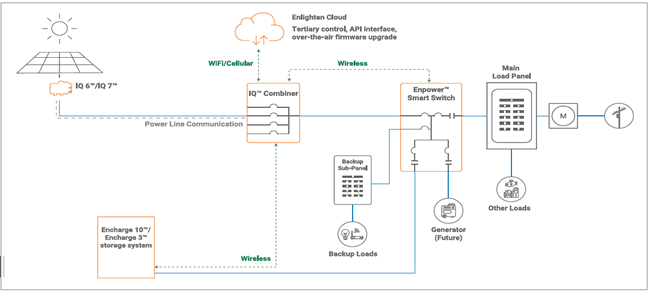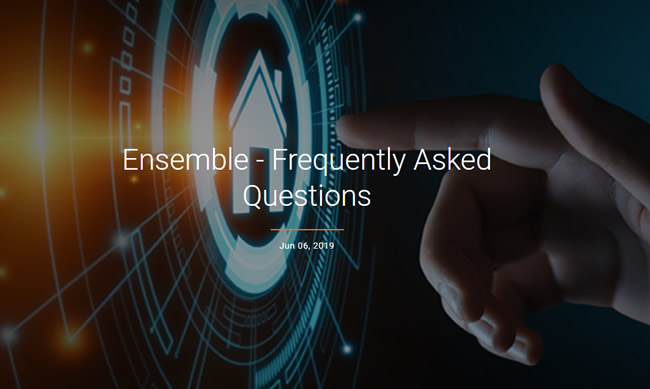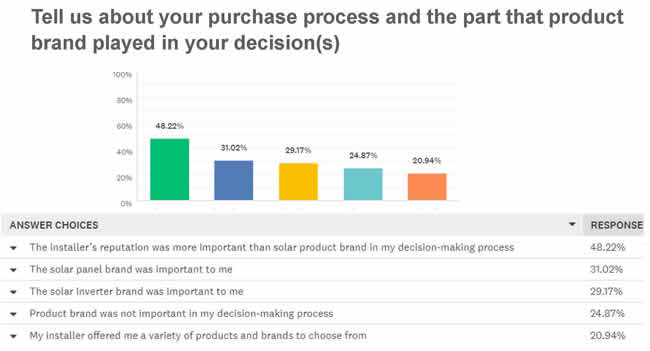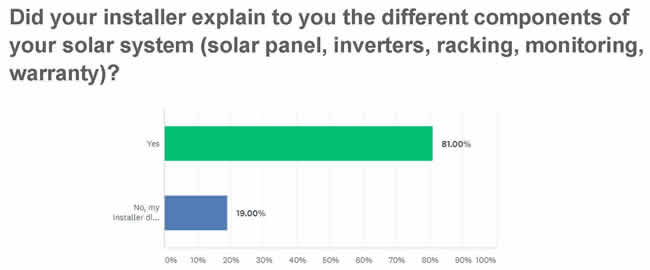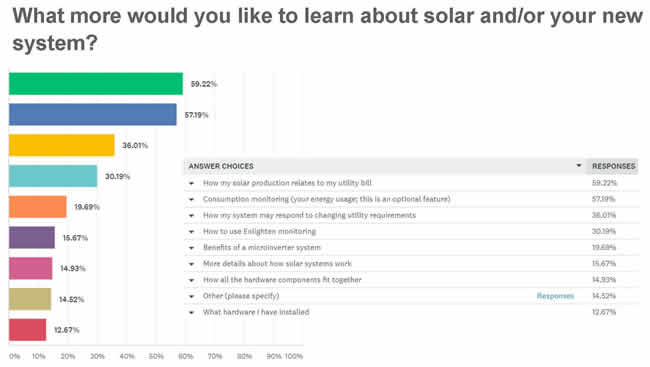Tag: "enphase"
11/11/19
Let's Talk Ensemble!
[Editor’s Note: Today is Veterans’ Day, so a shoutout to our Vets: Victoria and Greg,
and to all the Vets out there - thank you for your service to our country.]
The Enphase Ensemble system is almost here, so let’s start talking about how this is going to work for existing and potential clients.
What is Ensemble?
Ensemble is the name of the new Enphase storage and control system. It consists of the Enpower smart switch, some amount of Encharge battery systems (depending on your needs), and an IQ Envoy to handle communications. The system is capable of supporting “whole home” backup, although for most clients a “partial home” system will make more sense.
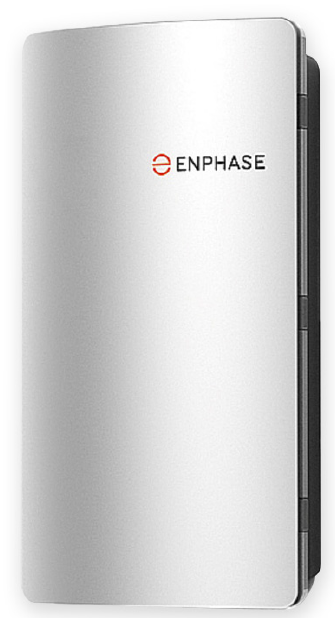 |
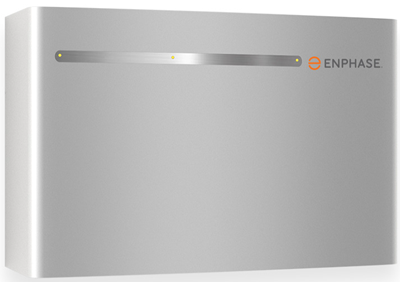 |
|
|
Enpower Smart Switch 19.7″ x 36″ x 9.7″ 80 lbs. |
Encharge 10 kWh Storage System 42.12″ x 26.14″ x 12.56″ 346 lbs. |
The Enpower smart switch contains an automatic transfer switch - or a Microgrid Interconnect Device, to use the language of the NEC (to isolate from the grid when there is a grid failure) - rated at 200 amps, and a neutral forming transformer to allow for 120/240 VAC operation.
The Encharge batteries come in two sizes: a 3.3 kWh battery and a 10 kWh battery (which is actually three of the 3.3 kWh batteries mounted behind a common cover). Inside the 3.3 kWh unit are four IQ8 microinverters, and thus 12 as part of the 10 kWh unit. The 10 kWh unit, which is going to be the minimum size that you will want, has a continuous output power of 3.84 kW, with a peak out of 5.7 kW for ten seconds - enough to allow for inrush current from motors, for example.
Both units have a NEMA 3R rating so they can be installed outdoors (though you will want them out of direct sunlight if possible), and come with a 10-year warranty.
How Will it Fit with My Existing System?
First, you need to have IQ microinverters. At least as of the initial rollout of this system, the older microinverters are not supported. That means that the M and S-series of microinverters have to be replaced to IQ-series microinverters to work with Ensemble. (I do not know if this will change in the future, but it is the guidance that we are getting at this time.) It is possible that there will be some sort of replacement program (like Enphase did with the legacy M-190 customers), but I have not gotten any word about such a plan yet.
Second, you need a rough parity between the output power of the solar array and the output power of the Encharge batteries. That means that if you have a single, 10 kWh Encharge battery system, the rated output power of the installed microinverters on the roof, has to be at or below 5.7 kW. Here’s what that means for the IQ microinverters that have been installed in the past three years:
As the systems that we have been installing have all been IQ6+ or IQ7+, you can see that with a 10 kWh Encharge system, you are limited to 19 panels - a 6.365 kW system when paired with LG 335’s.
How can I Plan to Make Ensemble Work Best for Me?
Making this work requires some planning and modifications, and not every existing system will be a good candidate for this. As we have noted in earlier posts about Ensemble, most folks in Southern California have what is called a combination service panel where the meter unit and the distribution unit (where the breakers are) are in the same, physical device. Without replacing the service panel, you are left with a configuration that will looks something like this:
That is your PV system in the top left powered by IQ microinverters. Those land on an IQ Combiner (which Run on Sun has been using since the IQ microinverters were rolled out). On the far right is the grid, feeding your meter and the service panel. (In an existing system, the output from the IQ Combiner goes to a disconnect switch and then to a breaker (or a lug) in the service panel.)
To add Ensemble, you need to connect the Enpower switch to the service panel via an appropriately sized breaker. You also need to create an emergency load subpanel, with the critical loads that you want to operate during an emergency. (This takes a good deal of thought - you will need to know the power requirements of the devices you are looking to operate during the outage and size the system accordingly.) Everything then flows through the Enpower switch (including the possibility of a backup generator, though that will not be immediately supported).
We do not yet know what the utilities or local AHJs will say about this. Presumably the utilities still want a lockable disconnect switch on the output from the Combiner, but will they also want one on the output of the Encharge battery system? The Encharge system allows for two, 10 kWh units to be “daisy-chained” together; for larger storage system a storage subpanel is required. Also required is consumption monitoring, which may not be possible on some service panels (due to space constraints) without rewiring the entire panel - ugh.
So… this is going to be a great product, but it is neither a cheap nor simple process. Interested? Let’s get started!
06/28/19
Categories: All About Solar Power, Residential Solar, Energy Storage
Ensemble Rollout Coming into Focus
On the heels of their video release last month, the folks at Enphase have now published an FAQ page on the entire Ensemble system. Here are some highlights…
Perhaps the most exciting item is that they are expecting deliveries around Christmas time – what a great gift! That said, I’m sure quantities are going to be limited at least initially. To that point, however, it looks like there will be a “pre-order” option - though the FAQ page is silent on details or pricing.
The most disappointing answer is that the system will not be compatible with S and M series microinverters, although they are planning an upgrade path, similar to the “Early Adopters” program that they had earlier this year.
Happy to hear your feedback - obviously we are following developments here closely, watch this space.
11/07/18
Categories: All About Solar Power, Residential Solar, Solar Repairs
Enphase announces Upgrade Program for Early Adopters...
One of the nagging concerns in the solar industry is what to do about those aging legacy systems? As systems age there can be reliability issues and finding compatible parts can be a real issue in a fast moving technology environment like solar power. Given all of that, we are pleased to announce the Enphase Update Program for Enphase Early Adopters. There is a lot to this program, including three distinct upgrade paths, so let’s break it down step-by-step…
Who is Eligible?
This program is dedicated to the earliest adopters of Enphase microinverters, specifically the M175, D380, M190, and M210 models. (Of the eligible microinverter models, Run on Sun only ever installed the M210.) System owners that have M215’s, M250’s, or S280 microinverters are not eligible for this program.
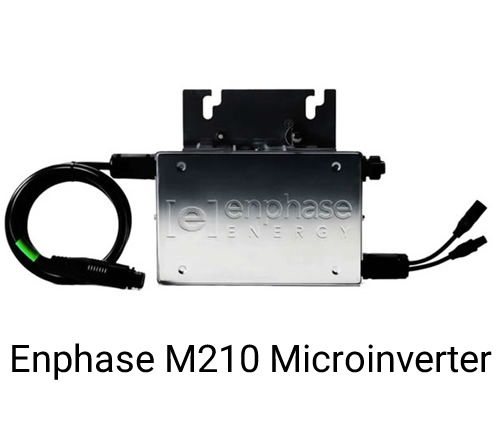 |
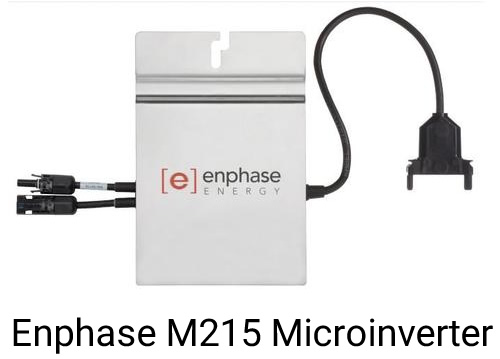 |
| The Enphase M210 qualifies for the upgrade… | While the subsequent generation M215 does not. |
What are My Options?
There are three upgrade paths with varying benefits, costs, and timing, however, all three offer full 25-year product warranties and a two year service agreement. The three options are: Microinverter Upgrade, Full-System Upgrade, and Next-Generation Upgrade - let’s take them one at a time.
Microinverter Upgrade
The most cost-effective option is the Microinverter Upgrade because it takes advantage of your existing solar panels that are likely still in good shape. This upgrade provides all of the following:
- New Enphase IQ7-PD - the latest generation microinverter, powered down to be compatible with existing, earlier generation systems.
- New interconnection cable
- New IQ Envoy with both production and consumption energy measuring devices* (CTs).
Legacy owners can purchase this equipment directly from Enphase for just $67.50/panel - a really great price. Removal and re-installation labor will vary widely based on various factors including the difficulty of the roof, the quality of the original installation, and whatever upgrades need to be done, probably on the order of $150/panel.
*Note that not all systems will be able to do consumption monitoring depending on the existing service panel configuration.
Full-System Upgrade
When microinverters like the M210 were being installed, available panel wattage was much lower than today, but with the advent of electric vehicles, homeowners are in need of more energy than ever. The Full-System Upgrade provides a way to gain from today’s higher power modules, but in a cost-effective manner.
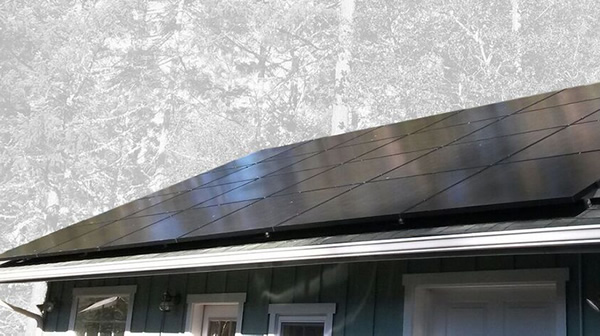
Enphase Energized Solaria PowerXT-AC Modules
This upgrade path involves the Enphase Energized Solaria PowerXT-AC Module, which has an Enphase IQ7+ microinverter integrated onto the Solaria module. (You can see an image of the Solaria modules on the left.)
The module has a power production of 295 Watts, substantially greater than what was available for legacy modules. The cost to the homeowner for this upgrade path is $469/panel, which includes the AC module, cabling, and the Envoy for monitoring.
Labor costs for this upgrade path are likely to be substantially higher, in part due to the need for new racking (the module dimensions are somewhat unusual - 63.8″ x 43.9″ - which could necessitate a racking change), changes in the sizing of the branch circuits, and the need to pull permits for the new system. Those factors are mitigated somewhat by the upgrade cost most likely qualifying for the federal 30% tax credit since it is an all new system, as opposed to the Microinverter Upgrade, that won’t.
Next-Generation Upgrade
Finally, the last upgrade option is to wait for the rollout of the Enphase IQ8 microinverter system. (You can read about what the IQ8 technology will provide here.) Unfortunately, there is no pricing information available yet for that upgrade path, and its availability is not until sometime in 2019 - probably the second quarter at the earliest.
What Happens if I do Nothing?
If your system is working fine, you don’t really have a need to do anything. However, these earlier microinverters came with a 15-year warranty, which means that more than half of that warranty period has expired. Moreover, particularly compared to the M190’s, the newest Enphase microinverters have significantly greater reliability (Enphase claims by an order of magnitude), so you would be upgrading to a more reliable product and extending your warranty protection by 25 years.
We will post again when we have more information regarding the Next-Generation, IQ8 upgrade. In the meantime, if you have questions about upgrading, please give us a call.
08/17/18
Categories: All About Solar Power, Residential Solar, Energy Storage
What I Saw at Enphase - Mind Blown!
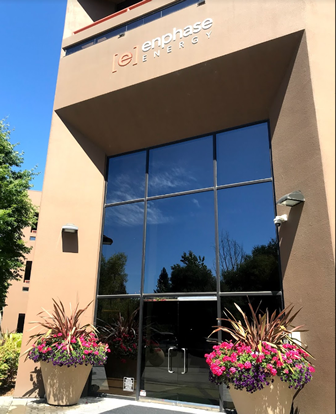 Last month during Intersolar, I (along with colleagues Sara and Victoria) was lucky enough to get invited to see a microgrid demonstration featuring the Enphase next-gen IQ8 at their headquarters in Petaluma, California. As I had to sign an NDA as the price of admission, I was unable to write about what I had seen until today, when Enphase hosted their annual Analyst’s Day. But I am no longer bound by that agreement, and can now tell you about what I saw.
Last month during Intersolar, I (along with colleagues Sara and Victoria) was lucky enough to get invited to see a microgrid demonstration featuring the Enphase next-gen IQ8 at their headquarters in Petaluma, California. As I had to sign an NDA as the price of admission, I was unable to write about what I had seen until today, when Enphase hosted their annual Analyst’s Day. But I am no longer bound by that agreement, and can now tell you about what I saw.
To say that I was impressed would be a gross understatement - quite simply, it was the most astonishing thing I have ever seen in the solar industry. Settle in and let me tell you what I saw…
What Happens Today
Before I launch into describing the demo, let me remind you of what happens today. All of the systems that we have installed are what is referred to as “grid-tied” which means that if the grid goes down, the PV system that is capable of back-feeding the grid also goes down, and remains down until the grid comes back. (This is to prevent your house from being an island of energy, feeding the grid, and potentially injuring a worker trying to restore grid service. As a result, this feature is known as “anti-islanding” and it is required of all inverter systems that are connected to the grid.)
Normally this is not a problem, but last month, when it got super hot out here (think 115° F hot!), both SCE and LADWP suffered dozens of outages, taking down PV systems across large swathes of LA County, and leaving frustrated PV owners without power, or A/C, just like their PV-less brethren. Not good.
What I Saw in the Lab
Which brings us to what I saw at Enphase last month.
The lab looked like an ordinary industrial space, but with a series of household appliances and tools at one side. There was a simulated array feeding a bank of IQ8 inverters, and a display that showed the output of the array (i.e., PV production), the total consumption from the loads, and any power being exported or imported to support those loads. At the start of the demo the only load was a single red lamp, and the display indicated that it was drawing roughly 90 Watts. The PV array was producing roughly 1.9 kWs, so the excess 1,800 Watts was being exported to the grid. All super normal stuff.
But then things got interesting…
One of the engineers switched off the breaker that connected the PV array to the grid… and nothing happened! Well, actually, a lot happened, but what didn’t happen was that the red light did not go off. It didn’t even flicker to the extent that we could detect it. But then when you looked at the display you noticed something amazing. Not only had the microinverters created a grid on their own in fractions of a second, but they had throttled the output down so that now the production of the PV array exactly matched the load of the red light! And here’s the kicker - there were no batteries attached to this system!!!
But what fun is just having a light on? How about some toast? So they switched on a toaster, and it lit up, and the total load jumped by about 1,000 Watts, making the total load now around 1.1 kW, and the PV array scaled up to meet it! Still no batteries. And how about this - there was no central controller, no master-slave relationship between the microinverters. Rather, this was the “hive mind” at work, as the micros sensed the demand and scaled up or down as necessary to meet that load!
But wait, there’s more!
The next load to be added was a grinder like you might find on your workbench in the garage. All by itself, that device drew roughly 1,200 Watts, bring our total load to roughly 2.3 kW - more than the maximum output of our simulated array. What would happen when that was added to the mix? Surprisingly little. The grinder spun normally, but the red light dimmed slightly. What was going on? The system’s “hive mind” had lowered the voltage slightly (a microgrid equivalent of a brown out) to meet the amperage demand of the new load mix! So slightly slower than normal, cooler than normal, dimmer than normal, but all operating.
Of course, all good things must come to an end. Our already overloaded microgrid faced one more challenge - a vacuum cleaner with a significant in-rush current, far in excess of what the grid could sustain. Indeed, as soon as they switched the vacuum cleaner to “on", everything shut off. Nothing was damaged, the microinverters just shut off to protect themselves.
Turning on the vacuum cleaner served as the “ah-ha” moment for the potential homeowner - I guess I can’t run everything in grid outage mode. So what do you do when something you just did produced an undesired result? Well if you can, you undo it! Turning the vacuum cleaner off, immediately restored the microgrid to its previous state of operation! No delay. No human intervention - just turn off that latest (over)load, and the system recovers on its own!
How cool is that? Pretty damn cool, if you ask me!
Batteries Please?
So what about batteries, how do they play with this new system? Just exactly as you would want.
The engineers added a bank of batteries to the mix, each with an IQ8 installed. Now the display also indicated the battery’s overall state of charge, and whether they were charging or discharging. Reset the demo to just the red light as a load and the batteries at 30% state of charge. The PV array output jumped back to its maximum, with the surplus energy being used to charge the batteries. As more loads were added, the PV array remained at maximum output, and as needed, drew power from the batteries. Should the batteries reach full capacity and the PV output is greater than the loads, the microinverters will once again throttle down.
Sweet!
What’s Next?
I hope you agree that this was an amazing demo, and the IQ8 (or Ensemble, as Enphase refers to the overall system) has tremendous potential, both for Enphase as a company, and for so many nascent markets. Think of how this product could have helped out in Puerto Rico, or in parts of Africa which have never, ever seen a grid! Makes me want to book a trip to bring power to a village somewhere - hey Laurel, what do you say?
For our own clients, this has the potential to be the answer we have been seeking ever since Elon’s whoppers got people thinking about storage for the first time ever.
A point we raised with Enphase management is the need to have a reasonable upgrade path for existing clients. Indeed, I have a call with Enphase tomorrow to discuss that very topic. We know that current Enphase IQ products (the 6+ and 7+ we have been installing this year) will be compatible with Ensemble. We expect to be able to work with older systems, though there may be a higher retrofit cost. When we have that information, we will surely let you know! The IQ8 is expected to be available in 1H2019… watch this space!
04/04/18
Categories: All About Solar Power, Residential Solar, Ranting
Why does a Solar Client Choose Enphase?
Our friends over at Enphase Energy just completed their most recent survey of solar clients who chose Enphase for their PV system. Since all of our clients for years now have benefitted from having an Enphase system installed, the insights that Enphase gleaned are pretty relevant to understanding our clients here at Run on Sun. So what did they find out?
Enphase identified three goals for their survey: Determine how homeowners decided to go solar and choose their installer; assess the role of brand name products in the purchasing decision; and see what, if any, questions remained unanswered. Let’s take those one at a time.
How Enphase Customers Chose Their Installer
Solar companies employ a variety of strategies for finding new clients, from door-to-door canvassing or cold calling leads, to print, radio, or TV advertising, as well as word of mouth. Of course, all but that last avenue can be trod simply by throwing money at the problem. Hence the very high cost of acquisition that we see for some of the national chains, in some cases upwards of $3,000/client!
How did Enphase customers choose their installer? The results are quite interesting:
Now that is interesting - over two-thirds of Enphase customers found their installer either by referrals or from doing their own Internet research! This tracks very closely with our own experience: we don’t purchase leads, we don’t cold-call people, and we don’t go knocking on their doors. We do devote a lot of energy to having a quality Internet presence (via both our website and this blog), and a significant percentage of our new clients are referrals from our earlier ones. It looks like we are meeting Enphase customer where they are looking!
It is interesting to see that third result - “My installer found me” - clearly represents all of those things we don’t do! So that explains why you are still getting dozens of calls and knocks on your door asking you to go solar – for 1 in 5 customers that approach works, at least when it comes to signing on the line that is dotted! (Actually, we use a solid line, but that’s an issue for another post!)
Oh, and those other forms of advertising? Looks pretty much like money down the drain – ouch!
The Importance of Product Branding
So now we know how these Enphase customers found installers to consider, but how did they make their purchase decision? Survey says:
Not surprisingly, the installer’s reputation was the most important factor, cited by nearly half of all respondents – which dovetails nicely with choosing the installer based on referrals.
At roughly 30% each, the brand name of the solar panel, and the inverter was important in the decision. This is interesting to me, and consistent with our experience. Maybe one client in three has a strong view on either the panel or the inverter when we first speak with them. Of course, that means LG and Enphase because that is all that we install. I suspect if you were to look at this question five years ago, the number of respondents saying brand was important to them would have been much smaller.
Oh, and again, the survey shows that we are missing out on one in five potential clients since their installer offered a variety of products from which to choose. In our view that is something of an abdication of our responsibility as pros. Our clients want to rely upon our expertise to guide them to the right choice – how are they supposed to know what it the best inverter or solar panel out there?
Questions, questions!
An important part of the installation process is to manage client expectations, and a key component of that is to answer their questions. So how good a job are installers doing at answering those questions? Survey says:
The overwhelming number of Enphase installers are answering their clients questions – good job! But interestingly, about one in five clients are being left in the dark about questions that they had regarding their systems. (I wonder if this is the same one in five who had the installer find them?)
For folks who have questions, what is it that they most want to know? Again, these open questions reflect on the need to manage expectations:
Not surprisingly, the number one question, asked by a 60% of respondents, is how does the production from the solar system relate to their electric bill! This is an extremely common concern – leading to that famous complaint: I’ve got solar, why is my bill so high? I think the evidence is overwhelming that solar installers need to do a better job of explaining how these systems will work in real life.
Are you a recent solar consumer? How do these results match up with your experience? We would love to hear your thoughts/experiences in the comments!

